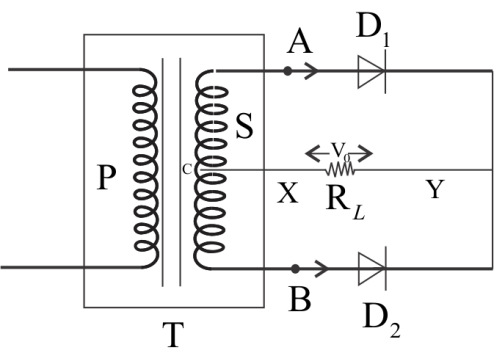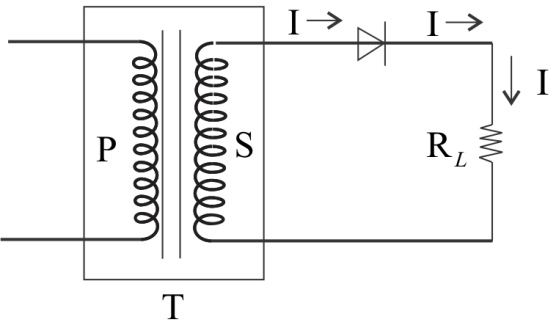
Suggest an idea to convert a full wave bridge rectifier to a half wave rectifier by changing the connecting wires. Draw the diagram and explain your answer.
Answer
559.2k+ views
Hint: To convert a full wave bridge rectifier to half wave rectifier, we need only one diode’s output, for achieving this condition, we should change the connection of resistance. The resistance blocks the working of one diode, thus we will get output from only one diode.
Complete step by step answer:
To understand this question first we need to understand what is a half wave rectifier so, the half wave rectifier is defined as a type of rectifier that allows only one half-cycle of an ${\text{AC}}$ voltage wave to pass and blocking the other half-cycle. Half wave rectifiers have only a single diode to construct.
The full wave rectifier has two diodes, so to convert it into a half wave rectifier, we simply have to change the connection of resistance, such that currents flow from one diode stops, and the final current flows only through one diode.
That considers a full wave rectifier and then we see how we can convert it.
Figure:

If we can see the figure, we see ${\text{P}}$ is a primary coil & ${\text{S}}$ is a secondary coil. And at point ${\text{C}}$ a load resistance ${{\text{R}}_{\text{L}}}$ is connected and the potential across it is ${{\text{V}}_{\text{0}}}$. In this condition current is flowing equally from both the diodes. If we cut the connection at Point ${\text{C}}$ and Join the load resistance with Point ${\text{B}}{\text{.}}$ we say that current which is induced in coil ${\text{S}}{\text{.}}$ will always goes towards ${{\text{D}}_{\text{1}}}$ diode, hence there is no current to ${{\text{D}}_{\text{2}}}$ diode.
Then the diode ${{\text{D}}_{\text{2}}}$ becomes dead and rest of the currents flows through the diode ${{\text{D}}_{\text{1}}}$. Then the circuit will be working as a half wave rectifier because only one diode is working in the whole septum.

We can consider the half wave rectifier as the simplest form of rectifier. We always use only a single diode to construct the half wave rectifier.
Additional Information: The half wave rectifier is made up of an ${\text{AC}}$ source, transformer (step down), diode, and resistor (load). The diode is placed between the resistor (load) and the transformer. The ${\text{AC}}$ source supplies alternating current to the circuit. The alternating current is usually represented by a sinusoidal waveform.
Note: A rectifier that utilizes both the negative and the positive half of the input signal and undergoes rectification is known as a full-wave rectifier. The average value of the output of the full-wave rectifier is higher when compared to that of a half-wave rectifier.
Complete step by step answer:
To understand this question first we need to understand what is a half wave rectifier so, the half wave rectifier is defined as a type of rectifier that allows only one half-cycle of an ${\text{AC}}$ voltage wave to pass and blocking the other half-cycle. Half wave rectifiers have only a single diode to construct.
The full wave rectifier has two diodes, so to convert it into a half wave rectifier, we simply have to change the connection of resistance, such that currents flow from one diode stops, and the final current flows only through one diode.
That considers a full wave rectifier and then we see how we can convert it.
Figure:

If we can see the figure, we see ${\text{P}}$ is a primary coil & ${\text{S}}$ is a secondary coil. And at point ${\text{C}}$ a load resistance ${{\text{R}}_{\text{L}}}$ is connected and the potential across it is ${{\text{V}}_{\text{0}}}$. In this condition current is flowing equally from both the diodes. If we cut the connection at Point ${\text{C}}$ and Join the load resistance with Point ${\text{B}}{\text{.}}$ we say that current which is induced in coil ${\text{S}}{\text{.}}$ will always goes towards ${{\text{D}}_{\text{1}}}$ diode, hence there is no current to ${{\text{D}}_{\text{2}}}$ diode.
Then the diode ${{\text{D}}_{\text{2}}}$ becomes dead and rest of the currents flows through the diode ${{\text{D}}_{\text{1}}}$. Then the circuit will be working as a half wave rectifier because only one diode is working in the whole septum.

We can consider the half wave rectifier as the simplest form of rectifier. We always use only a single diode to construct the half wave rectifier.
Additional Information: The half wave rectifier is made up of an ${\text{AC}}$ source, transformer (step down), diode, and resistor (load). The diode is placed between the resistor (load) and the transformer. The ${\text{AC}}$ source supplies alternating current to the circuit. The alternating current is usually represented by a sinusoidal waveform.
Note: A rectifier that utilizes both the negative and the positive half of the input signal and undergoes rectification is known as a full-wave rectifier. The average value of the output of the full-wave rectifier is higher when compared to that of a half-wave rectifier.
Recently Updated Pages
A man running at a speed 5 ms is viewed in the side class 12 physics CBSE

The number of solutions in x in 02pi for which sqrt class 12 maths CBSE

State and explain Hardy Weinbergs Principle class 12 biology CBSE

Write any two methods of preparation of phenol Give class 12 chemistry CBSE

Which of the following statements is wrong a Amnion class 12 biology CBSE

Differentiate between action potential and resting class 12 biology CBSE

Trending doubts
What are the major means of transport Explain each class 12 social science CBSE

Which are the Top 10 Largest Countries of the World?

Draw a labelled sketch of the human eye class 12 physics CBSE

How much time does it take to bleed after eating p class 12 biology CBSE

Explain sex determination in humans with line diag class 12 biology CBSE

When was the first election held in India a 194748 class 12 sst CBSE




